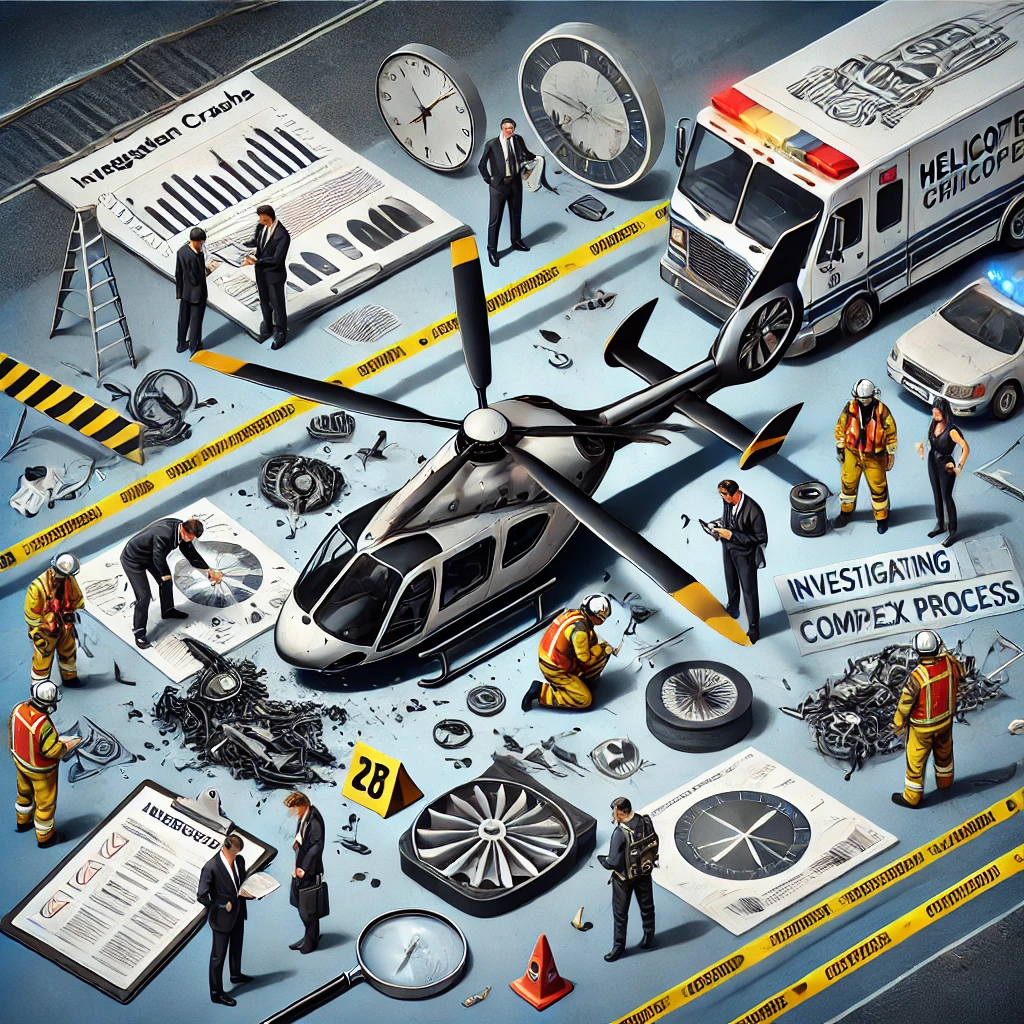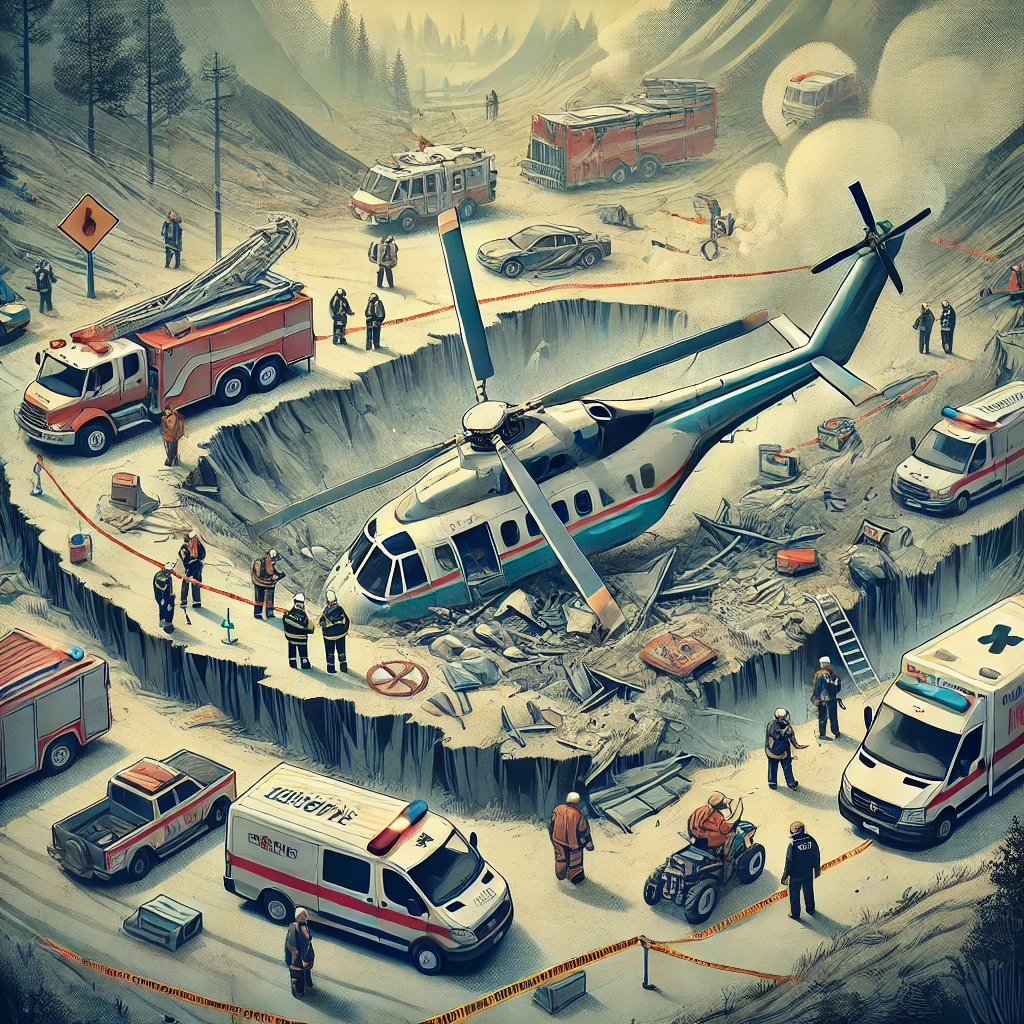Helicopter crashes are among the most shocking and tragic accidents, often making headlines worldwide due to the devastation they cause. These incidents involve intricate investigations, numerous contributing factors, and an overwhelming emotional impact. In this blog post, we explore what leads to helicopter crashes, recount notable incidents, and discuss safety measures that could prevent future tragedies.
Understanding the Causes of Helicopter Crashes
Helicopters, with their unique ability to hover and land in confined spaces, serve various purposes—from military operations to medical rescues and luxury transportation. However, these machines are also highly complex, requiring precise handling and continuous maintenance. Several factors contribute to helicopter crashes, including:
1.Mechanical Failures
Engine malfunction: Engine-related issues can result in sudden power loss, leading to a crash if the helicopter cannot safely autorotate to the ground.
Rotor problems: Since the rotor blades are central to a helicopter’s flight, any issue—like cracked blades or gearbox failures—can cause catastrophic accidents.
Hydraulic system failure: The hydraulic system assists in controlling the aircraft; failure here means the pilot may struggle to maneuver the helicopter.
2. Pilot Error
Inexperience: Helicopters require a different skill set than fixed-wing aircraft. Mistakes by inexperienced pilots are a leading cause of crashes.
Spatial disorientation: During poor visibility conditions, pilots can become disoriented, losing track of the helicopter’s position and altitude.
Fatigue and decision-making errors: Long flight hours can exhaust pilots, leading to impaired judgment during critical moments.
3. Weather Conditions
Low visibility: Fog, heavy rain, or snow makes navigation extremely challenging and increases the risk of collisions with obstacles.
High winds: Strong winds can destabilize a helicopter, especially during landing or takeoff.
Icing: In colder climates, ice can build on the rotors, affecting lift and stability.
4. Human Factors Beyond the Pilot
Air traffic miscommunication: Miscommunication between air traffic control and the pilot can lead to crashes, especially in busy airspaces.
Maintenance errors: Improperly performed maintenance or missed inspections can result in mechanical failures during flight.
Notable Helicopter Crashes and Their Impact
1. Kobe Bryant Helicopter Crash (2020)
In January 2020, a Sikorsky S-76B carrying NBA star Kobe Bryant, his daughter Gianna, and seven others crashed in Calabasas, California. The helicopter was flying through dense fog, and the pilot reportedly became disoriented, leading to the tragic accident. This incident shook the world and highlighted the importance of weather monitoring and pilot training.
2. UK Leicester City Helicopter Crash (2018)
In October 2018, a helicopter carrying Vichai Srivaddhanaprabha, the owner of Leicester City Football Club, crashed shortly after takeoff from the King Power Stadium. A tail rotor issue caused the helicopter to spin uncontrollably, resulting in the tragic deaths of all five onboard.
3. Military Black Hawk Down Incident (1993)
During the infamous Battle of Mogadishu, two U.S. Army Black Hawk helicopters were shot down, resulting in several deaths and injuries. The incident highlighted the dangers of combat operations involving helicopters and emphasized the need for enhanced tactical strategies.
Survivability and Safety Measures
While helicopter crashes often result in fatalities, survival is possible under certain conditions. Thanks to advancements in safety technologies and operational practices, fatalities have decreased in some regions. Here are a few factors that improve the odds of survival:
1. Autorotation: The Last Resort
If a helicopter loses engine power, the pilot can perform an autorotation, using the rotor’s momentum to control the descent. Proper pilot training is critical for executing this maneuver successfully and minimizing impact.
2. Safety Equipment
Crashworthy seats and fuel tanks: These reduce the risk of injury and explosion upon impact.
Life vests and rafts: Especially for helicopters flying over water, life-saving equipment can make the difference between survival and death.
Flight data and cockpit voice recorders: While not directly related to survival, these devices provide vital information during crash investigations and help prevent future accidents.
3. Pre-Flight and In-Flight Checks
Comprehensive pre-flight inspections: Ensuring that the aircraft is in optimal condition before takeoff can prevent mechanical failures.
Flight planning: Avoiding bad weather and using clear flight paths can reduce risks significantly.
Real-time monitoring systems: Advanced systems provide continuous feedback about the helicopter’s status, alerting the pilot to any emerging issues.
Investigating Helicopter Crashes: A Complex Process

After a helicopter crash, investigation teams must meticulously analyze every aspect of the incident to determine its cause. This process involves:
1. Site Investigation
Investigators collect debris, check the wreckage for mechanical failures, and identify any environmental factors (like obstacles) that may have contributed to the crash.
2. Black Box Data Analysis
In helicopters equipped with flight recorders, the data provides critical insights into the aircraft’s behavior and the pilot’s actions before the crash.
3. Weather Reports and ATC Communication
Analyzing weather data and air traffic control communications helps determine if external factors or miscommunication played a role.
4. Interviews with Witnesses and Experts
Investigators also interview eyewitnesses, surviving passengers (if any), and maintenance crew to piece together what happened.
The findings are then compiled into a detailed report, which often includes recommendations to prevent future accidents.
What Can Be Done to Prevent Helicopter Crashes?
Although helicopters inherently carry more risks than airplanes, steps can be taken to improve safety:
1. Enhanced Pilot Training
Pilots must undergo rigorous training to handle various emergency scenarios, including engine failures and disorientation during poor visibility.
2. Better Weather Monitoring Systems
Advanced weather forecasting tools allow pilots to plan routes more effectively and avoid dangerous conditions.
3. Improved Air Traffic Control Systems
Seamless communication between helicopters and air traffic controllers ensures safer navigation, especially in crowded airspaces.
4. Maintenance and Inspections
Strict maintenance schedules, with detailed inspections, help identify potential issues before they become dangerous.
The Psychological and Economic Impact of Helicopter Crashes
Helicopter crashes are not only a loss of life but also leave lasting scars on families, communities, and industries. Here are some of the major consequences:
1. Emotional Trauma and Grief
Families of victims face tremendous grief and often require psychological support. Survivors, too, may experience long-term emotional trauma.
2. Financial Losses
Airlines and helicopter companies: Crashes often lead to lawsuits, insurance claims, and a loss of reputation.
Businesses relying on helicopters: Companies offering helicopter tours, medical evacuation services, or transportation face significant financial risks following an accident.
3. Regulatory Changes and Industry Impact
Major helicopter crashes frequently lead to stricter aviation regulations. For instance, after the Kobe Bryant crash, there was increased scrutiny on safety protocols in private aviation.
Helicopter Safety in the Future: Technology to the Rescue
The future of helicopter safety lies in technological advancements. Here are a few promising innovations:
1. Autonomous Helicopters
With the development of AI and automation, pilotless helicopters are being tested. Autonomous systems reduce human error and make safer flights possible.
2. Enhanced Flight Control Systems
New flight control technologies offer better stability, especially during challenging weather conditions.
3. Hybrid and Electric Helicopters
The shift towards electric-powered aircraft promises more reliable engines and fewer mechanical failures, ultimately enhancing safety.
Conclusion
Helicopter crashes, though relatively rare, remain tragic events that highlight the challenges of aviation. With a better understanding of the causes—ranging from mechanical failures to human errors—aviation experts continue to explore ways to enhance safety. By embracing advanced technology, rigorous pilot training, and strict maintenance routines, the aviation industry aims to prevent future helicopter crashes and minimize their impact when they do occur.
—
FAQs
1. What is the most common cause of helicopter crashes?
Pilot error, mechanical failure, and adverse weather conditions are the leading causes of helicopter crashes.
2. Can helicopters land safely after engine failure?
Yes, helicopters can perform a maneuver called autorotation, which allows for a controlled descent even without engine power.
3. How often do helicopter crashes occur?
While helicopter crashes are less common than car accidents, they tend to have higher fatality rates due to the nature of the incidents.
4. What are some recent helicopter crash incidents?
The Kobe Bryant helicopter crash in 2020 and the Leicester City crash in 2018 are among the most notable recent tragedies.
5. Are helicopters safe to fly?
When operated and maintained properly, helicopters are relatively safe. However, they require meticulous attention to detail in terms of maintenance, pilot training, and weather monitoring.
This post aimed to provide an in-depth exploration of helicopter crashes, their causes, and preventive measures. By understanding these factors, we can appreciate the complexities of aviation safety and the efforts required to prevent future tragedies.


1 thought on “Tragedy in the Skies: A Closer Look at Helicopter Crashes”